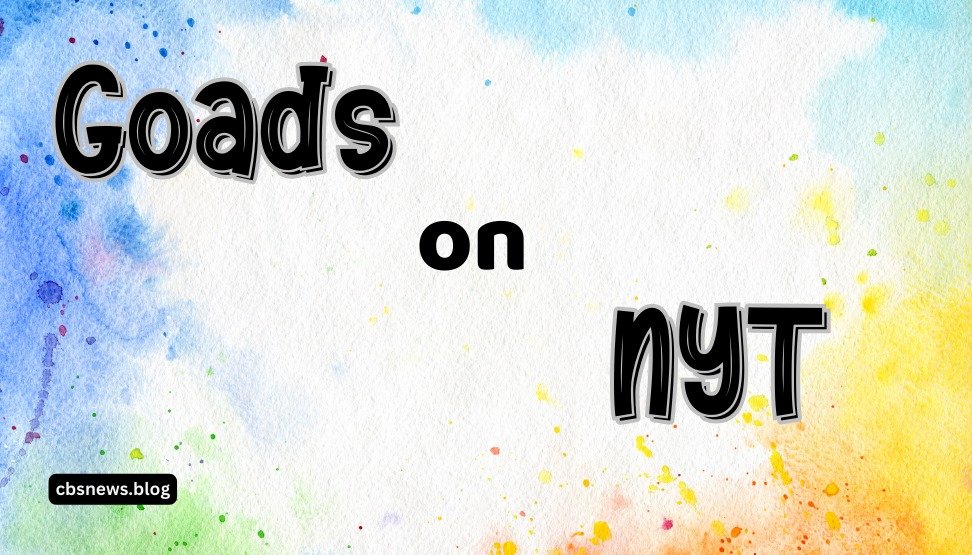Unraveling the Intricacies of “Goads on NYT” Phenomenon
In the ever-evolving panorama of media and journalism, sure phrases regularly emerge: taking pictures as a hobby and sparking discussions. “Goads on NYT” is one such term that has, in recent times, received traction, invoking curiosity and prompting inquiries into its means and implications. In this whole exploration, we delve into the depths of this phenomenon, uncovering its origins, manifestations, and importance in the modern-day media landscape.
Origins and Evolution of the Term
To apprehend “Goads on NYT,” we should first dissect its components. The New York Times (NYT), renowned for its journalistic integrity and impact, serves the truth as the backdrop in opposition to which the period unfolds. A “good,” then again, denotes a stimulus or provocation frequently supposed to evoke a reaction. When blended, “Goads on NYT” advises a planned try to incite or have an effect on the prominent guide.
The period’s origins can be traced to the lower return to the proliferation of social media and digital systems, in which individuals and businesses leverage various strategies to shape narratives and sway public opinion. These “goads” can also take the shape of wrong statistics, disinformation, sensationalism, or ideological manipulation, all aimed closer to exerting stress on the NYT and its reporting.
Manifestations in the Digital Age
In the modern-day digital age, the dissemination of facts has ended up democratized, permitting virtually all and sundry with a web connection to participate in shaping public discourse. While this democratization fosters a fashion of perspectives, it additionally opens the door to manipulation and exploitation. “Goads on NYT” exemplifies how this dynamic plays out, with actors beginning from overseas entities to domestic hobby corporations using techniques to steer the NYT’s insurance.
One outstanding manifestation of “Goads on NYT” is the unfolding of incorrect facts via social media channels. False narratives, conspiracy theories, and propaganda are regularly propagated to discredit the NYT or undermine don’t forget in its reporting. In a few cases, coordinated disinformation campaigns are searching to distort facts and promote possible agendas, posing a compelling mission to the integrity of journalistic institutions.
Implications for Media Integrity and Public Discourse
The prevalence of “Goads on NYT” poses extensive annoying conditions for media integrity and the broader landscape of public discourse. As agreed with traditional media institutions, the proliferation of wrong records threatens to undermine democratic thoughts and sow department internal society. Moreover, blurring lines between fact and fiction complicates the challenge of discerning reality from falsehood, leaving the public liable to manipulation and exploitation.
In response to those traumatic conditions, media businesses, much like the NYT, are forced to comply and innovate, imposing strategies to fight wrong records and uphold journalistic requirements. Fact-checking tasks, transparency measures, and collaboration with expert companions are the various techniques hired to shield the integrity of reporting and rebuild acceptance as accurate with audiences.
Navigating the Complexities of Modern Media
As we navigate the complexities of present-day media, confronting phenomena like “Goads on NYT” requires a multifaceted method. Media literacy education performs an essential function in empowering people to noticeably take a look at data and figure credible belongings from wrong information. By equipping the general public with the gear to navigate the digital landscape, we can mitigate the impact of “goads” and foster a more knowledgeable and resilient society.
Furthermore, stakeholders, including media and tech businesses, need collaboration. Policymakers and civil society—are crucial to addressing the reasons for inspiration. For misinformation and maintaining the integrity of our facts ecosystem. By jogging collectively to find out and counteract manipulative techniques. We can uphold the mind of truth, responsibility, and transparency upon which democracy relies.
Conclusion:
Ultimately, “Goads on NYT” encapsulates the myriad of disturbing situations. With modern media in a technology defined via statistics abundance and digital connectivity. As we confront the proliferation of wrong facts and manipulation. It’s miles essential that we stay vigilant in safeguarding the integrity of journalistic establishments similar to the NYT. We are capable of nurturing by fostering media literacy, promoting transparency, and fostering collaboration. A resilient media environment that can withstand the pressures of disinformation and uphold the thoughts of democracy and fact.
FAQs About “Goads on NYT”
What exactly are “Goads on NYT”?
“Goads on NYT” communicates various stimuli or provocations aimed. They influence or manipulate the reporting and narratives of The New York Times (NYT). These can encompass incorrect information, disinformation, sensationalism, or ideological manipulation propagated via digital structures and social media.
Who is within the again of the propagation of “Goads on NYT”?
The perpetrators of “Goads on NYT” can range substantially. They are starting from foreign places entities to domestic hobby agencies or humans with ideological agendas. These actors may additionally try to undermine or agree with the NYT. Discredit its reporting or promote possible narratives to enhance their pursuits.
How does “Goads on NYT” affect the integrity of journalism?
The proliferation of “Goads on NYT” poses big annoying situations to the integrity of journalism via blurring. The traces between reality and fiction erode recall in conventional media institutions. And it is complicating the project of discerning truth from falsehood. This can undermine public discourse and democratic thoughts.
What measures are being taken to fight “Goads on NYT”?
Much like the NYT, media businesses are implementing numerous techniques to combat “Goads on NYT.” Collectively with fact-checking tasks, transparency measures, and collaboration with valid companions. Additionally, efforts to sell media literacy and critical questioning abilities are essential in empowering individuals to navigate the digital landscape.
How can people contribute to mitigating the effect of “Goads on NYT”?
Individuals can mitigate the impact of “Goads on NYT” by staying knowledgeable and significantly comparing facts in advance rather than sharing them, helping credible journalism, and advocating for media literacy education. By being discerning clients of facts, people can help uphold the integrity of journalism and foster an extra-resilient media ecosystem.
Read also:



Pingback: An In-depth Look at Proof Technologies - Cbs News Blog